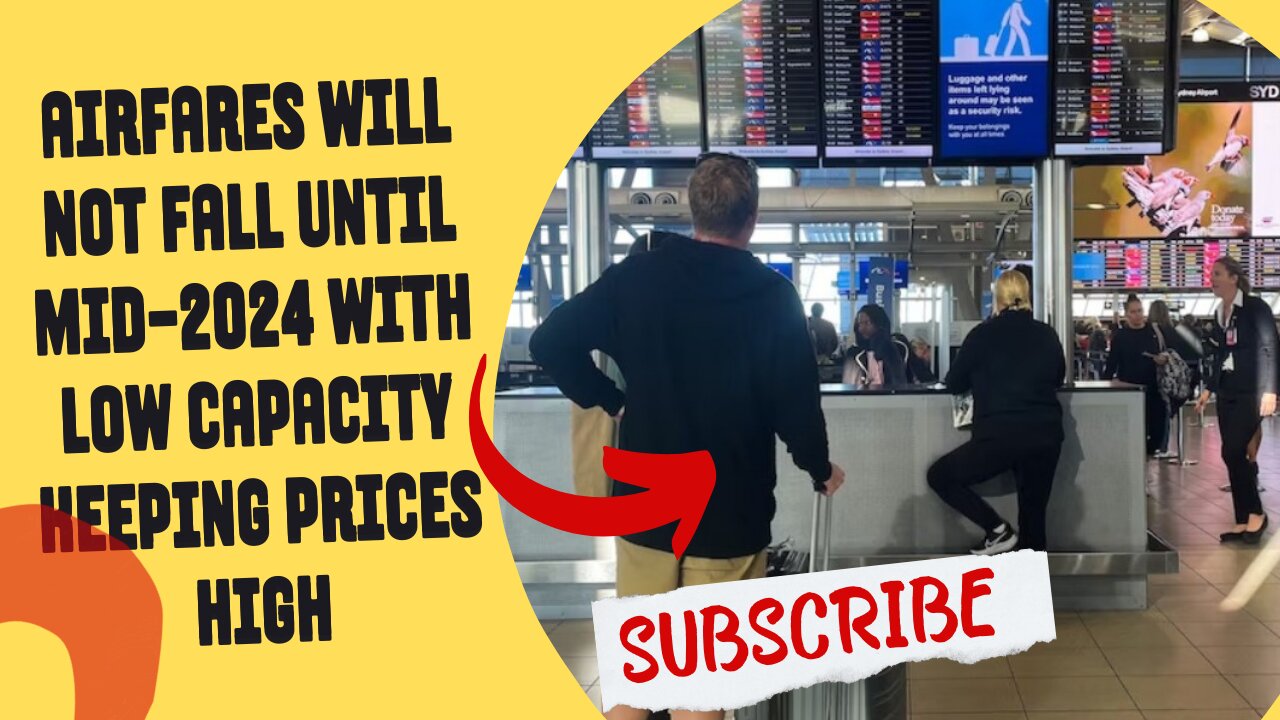Premium Only Content

Airfares will not fall until mid-2024 with low capacity keeping prices high
Airfares will not fall until mid-2024 with low capacity keeping prices high and regional routes worst affected, experts say
Teree Burr used to travel for work every month — but that has stopped because of the soaring cost of flights.
Ms Burr runs a tourism and events company in Nundle in the New England region of New South Wales and has had to cut back on business travel because of the high cost of flights from nearby Tamworth airport.
"I just simply can't afford the outlay of the travel now, to be in Sydney. I used to be in Sydney or Melbourne at least every four weeks, once a month," she said.
Ms Burr said the pre-pandemic $89 one-way flight from Tamworth to Sydney now costs at least $200 and flights were often cancelled.
One part of life that hasn't got back to normal after the COVID-19 pandemic has been cheap airfares — and nowhere is the expense of flying being felt more than in country Australia.
David Beirman, adjunct fellow in management and tourism at Sydney's University of Technology, said fares were now competitive on "heavily travelled" routes like Sydney to Melbourne and Sydney to Brisbane but in regional flights were still high.
"Many regional airfares in Australia actually will probably remain high because the airlines who operate there treat those routes as a cash cow," he said.
"From their point of view, they don't lose as many customers by ripping people off in the regions as they do if they try to rip them off between capital cities or between popular holiday destinations like the Gold Coast and the Sunshine Coast."
A Qantas spokesperson rejected this claim.
"While there are some realities about the cost of operating regional flights that we can't change, our resident fare program is designed to make regional air travel more accessible for residents while ensuring it remains sustainable," they said.
A Virgin Airlines spokesperson said the airline understood the importance of providing affordable airfares for residents living in regional areas and worked to deliver value and choice to Australian travellers.
REX winds back on regional routes
Regional residents are set to have even fewer flights with Rex Airlines' recent announcement that they were cutting NSW flights between Sydney and Albury, Coffs Harbour, Griffith, Narrandera, Orange, Parkes, Armidale and Port Macquarie.
A spokesman for Rex pointed to their announcement of changes to regional flights in April, citing a "chronic shortage of airline professionals, particularly pilots and engineers", as well as disruptions to the aircraft parts supply chain.
Ms Burr said some people living in New England needed to fly to Sydney for medical reasons.
"Increasingly what we're seeing in Tamworth is those flights are regularly being cancelled," she said.
"And because they only do one flight twice a week or something like that, you can't get on another flight same day."
The Bureau of Infrastructure and Transport Research Economics (BITRE) collects airline data on domestic and international flights.
BITRE's fare index showed that domestic airfares peaked in October last year and had fallen back close to pre-COVID levels.
The cheapest available price has increased by only 11 per cent on the Melbourne to Sydney route compared with pre-COVID, but has more than doubled on the Coffs Harbour to Sydney route.
They are a third higher on the Sydney to Tamworth route.
Lower capacity means higher fares
Dr Beirman said airline capacity was the main factor affecting airfares.
The BITRE data showed that overall, the number of seats available on international flights was 76 per cent of pre-COVID levels and on domestic flights was 97 per cent.
While many Australian cities have roughly the same number of available seats as pre-COVID, some popular holiday destination routes, such as Ballina to Sydney and Hamilton Island to Sydney, have up to 50 per cent more seats than before COVID.
Meanwhile, regional routes, such as Coffs Harbour to Sydney or Melbourne to Mildura, have up to 40 per cent less seats available than pre-COVID levels.
Dr Beirman said while capacity was continuing to recover to 2019 levels, fares would stay high.
"I don't honestly foresee airfares across the board coming down much until about mid-2024," he said.
No return of airfares to pre-COVID levels
International airfares are also "stubbornly" high on most routes, according to Flight Centre Travel Group CEO Graham Turner.
He said restricted capacity and high demand was "by far" the biggest factor keeping airfares high.
"Anyone who's flown recently internationally, it'll be obvious that there's just not spare seats around," he said.
Mr Turner said international flights out of Sydney through the Middle East were only at 70 per cent of pre-COVID levels.
The data showed that seat availability in and out of the Middle East in March this year was 60 per cent of the seat numbers in March 2019.
Capacity to the US was 78 per cent of pre-COVID levels and 93 per cent to Singapore, which Mr Turner said was reflected in cheaper airfares to those destinations.
Dr Beirman said before COVID, airlines were running "on the smell of an oily rag" with a business model of "high volume and low yield".
It created a lot of competition between airlines and bargains for customers.
He said the COVID crisis resulted in airlines amassing huge debts and reassessing how they ran the business as the pandemic ended.
"If you look at the big picture, the expectation that people had that because tourism was recovering that airfares would drop down, is a bit of an urban myth," he said.
He did not expect airfares to Europe and North America to go back to 2019 levels.
"I think airlines now realise they can't operate on a 0.5 per cent yield, they need to have a little bit more than that," he said.
Push to ease restrictions on capacity
Transport Minister Catherine King recently blocked Qatar Airways from doubling their number of flights into Australia.
Mr Turner said the federal government needed to ease restrictions on capacity.
Australia has air service agreements, which allow airlines to schedule flights within defined capacity entitlements, with more than 60 countries, but not with Qatar.
"It depends on the government attitude. Whether they want cheaper airfares, or they want to keep the fares high, which seems to be their policy at the moment," Mr Turner said.
A spokeswoman fo Ms King said scheduled international flights were projected to return to around 91 per cent of pre-COVID levels in September.
The data for September has not yet been released.
"Qatar airlines could also increase its capacity today by flying larger planes to the main international airports, as Etihad has announced it will do next month, and by choosing to exercise its unlimited rights to fly into Canberra, Cairns, Gold coast and other secondary international airports in Australia," she said.
-
 LIVE
LIVE
vivafrei
2 hours agoAcosta AI Interview: Journalism or Exploitation? The War of the Jeans! Cincinnati Update & MORE!
12,378 watching -
 LIVE
LIVE
The Quartering
2 hours agoClintons To Testify, Zoo Asks For Peoples Pets For Food, Young Voters, GTA To Require ID To Play
7,740 watching -
 LIVE
LIVE
Awaken With JP
1 hour agoArrest Warrants for Dems, MSNBC Sucks, and More - LIES Ep 103
1,599 watching -
 LIVE
LIVE
Barry Cunningham
4 hours agoREACTING TO THE PRESIDENT TRUMP INTERVIEW ON CNBC! (THE CONTRAST OF COMMUNISM AND MORE NEWS))
3,754 watching -
 1:58:54
1:58:54
The Charlie Kirk Show
3 hours agoThe Obamagate Grand Jury + The Mamdani/Warren Alliance | Prof. Steele, Brand | 8.5.2025
53.4K22 -
 1:20:03
1:20:03
Sean Unpaved
3 hours agoNFL Coaching Edge: Top Staffs, Rookie Head Coaches, & NFC South Breakdown
23.5K -
 LIVE
LIVE
Viss
4 hours ago🔴LIVE - Adrenaline Infused PUBG Tactics The Get Wins! - PUBG
294 watching -
 16:22
16:22
Clickbait Wasteland
19 hours ago $1.20 earnedAsking New Yorkers Who They Support For Mayor: Upper West Side
15.2K5 -
 LIVE
LIVE
StoneMountain64
2 hours agoBATTLEFIELD 6 BETA Training and Prepping
150 watching -
 38:51
38:51
Members Club
2 hours ago $0.48 earnedWNBA Madness, Biohacker Oversharing, & Red-Pilled Denim
17.7K3